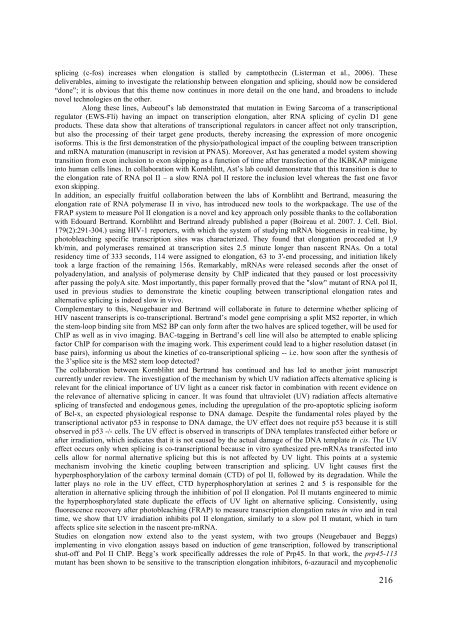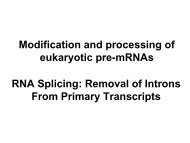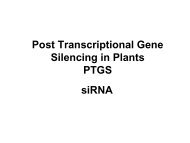You also want an ePaper? Increase the reach of your titles
YUMPU automatically turns print PDFs into web optimized ePapers that Google loves.
splicing (c-fos) increases when elongation is stalled by camptothecin (Listerman et al., 2006). Thesedeliverables, aiming to investigate the relationship between elongation and splicing, should now be considered“done”; it is obvious that this theme now continues in more detail on the one hand, and broadens to includenovel technologies on the other.Along these lines, Aubeouf’s lab demonstrated that mutation in Ewing Sarcoma of a transcriptionalregulator (EWS-Fli) having an impact on transcription elongation, alter RNA splicing of cyclin D1 geneproducts. These data show that alterations of transcriptional regulators in cancer affect not only transcription,but also the processing of their target gene products, thereby increasing the expression of more oncogenicisoforms. This is the first demonstration of the physio/pathological impact of the coupling between transcriptionand mRNA maturation (manuscript in revision at PNAS). Moreover, Ast has generated a model system showingtransition from exon inclusion to exon skipping as a function of time after transfection of the IKBKAP minigeneinto human cells lines. In collaboration with Kornblihtt, Ast’s lab could demonstrate that this transition is due tothe elongation rate of RNA pol II – a slow RNA pol II restore the inclusion level whereas the fast one favorexon skipping.In addition, an especially fruitful collaboration between the labs of Kornblihtt and Bertrand, measuring theelongation rate of RNA polymerase II in vivo, has introduced new tools to the workpackage. The use of theFRAP system to measure Pol II elongation is a novel and key approach only possible thanks to the collaborationwith Edouard Bertrand. Kornblihtt and Bertrand already published a paper (Boireau et al. 2007. J. Cell. Biol.179(2):291-304.) using HIV-1 reporters, with which the system of studying mRNA biogenesis in real-time, byphotobleaching specific transcription sites was characterized. They found that elongation proceeded at 1,9kb/min, and polymerases remained at transcription sites 2.5 minute longer than nascent RNAs. On a totalresidency time of 333 seconds, 114 were assigned to elongation, 63 to 3'-end processing, and initiation likelytook a large fraction of the remaining 156s. Remarkably, mRNAs were released seconds after the onset ofpolyadenylation, and analysis of polymerase density by ChIP indicated that they paused or lost processivityafter passing the polyA site. Most importantly, this paper formally proved that the "slow" mutant of RNA pol II,used in previous studies to demonstrate the kinetic coupling between transcriptional elongation rates andalternative splicing is indeed slow in vivo.Complementary to this, Neugebauer and Bertrand will collaborate in future to determine whether splicing ofHIV nascent transcripts is co-transcriptional. Bertrand’s model gene comprising a split MS2 reporter, in whichthe stem-loop binding site from MS2 BP can only form after the two halves are spliced together, will be used forChIP as well as in vivo imaging. BAC-tagging in Bertrand’s cell line will also be attempted to enable splicingfactor ChIP for comparison with the imaging work. This experiment could lead to a higher resolution dataset (inbase pairs), informing us about the kinetics of co-transcriptional splicing -- i.e. how soon after the synthesis ofthe 3’splice site is the MS2 stem loop detected?The collaboration between Kornblihtt and Bertrand has continued and has led to another joint manuscriptcurrently under review. The investigation of the mechanism by which UV radiation affects alternative splicing isrelevant for the clinical importance of UV light as a cancer risk factor in combination with recent evidence onthe relevance of alternative splicing in cancer. It was found that ultraviolet (UV) radiation affects alternativesplicing of transfected and endogenous genes, including the upregulation of the pro-apoptotic splicing isoformof Bcl-x, an expected physiological response to DNA damage. Despite the fundamental roles played by thetranscriptional activator p53 in response to DNA damage, the UV effect does not require p53 because it is stillobserved in p53 -/- cells. The UV effect is observed in transcripts of DNA templates transfected either before orafter irradiation, which indicates that it is not caused by the actual damage of the DNA template in cis. The UVeffect occurs only when splicing is co-transcriptional because in vitro synthesized pre-mRNAs transfected intocells allow for normal alternative splicing but this is not affected by UV light. This points at a systemicmechanism involving the kinetic coupling between transcription and splicing. UV light causes first thehyperphosphorylation of the carboxy terminal domain (CTD) of pol II, followed by its degradation. While thelatter plays no role in the UV effect, CTD hyperphosphorylation at serines 2 and 5 is responsible for thealteration in alternative splicing through the inhibition of pol II elongation. Pol II mutants engineered to mimicthe hyperphosphorylated state duplicate the effects of UV light on alternative splicing. Consistently, usingfluorescence recovery after photobleaching (FRAP) to measure transcription elongation rates in vivo and in realtime, we show that UV irradiation inhibits pol II elongation, similarly to a slow pol II mutant, which in turnaffects splice site selection in the nascent pre-mRNA.Studies on elongation now extend also to the yeast system, with two groups (Neugebauer and Beggs)implementing in vivo elongation assays based on induction of gene transcription, followed by transcriptionalshut-off and Pol II ChIP. Begg’s work specifically addresses the role of Prp45. In that work, the prp45-113mutant has been shown to be sensitive to the transcription elongation inhibitors, 6-azauracil and mycophenolic216







